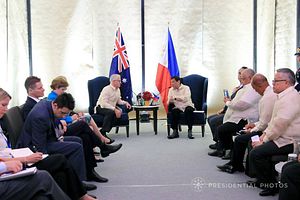This week, an Australian firm confirmed that it would be helping build new patrol vessels for the navy of the Philippines. While some specifics are still unclear, the news nonetheless once again put the focus on the Australia-Philippine defense relationship, which has seen an uptick of activity over the past few years amid ongoing challenges.
As I have noted previously in these pages, Australia and the Philippines have long had a strong defense relationship, with ties including not just regular interactions like exchanges and exercises but capacity-building in areas ranging from maritime security to counterterrorism, assistance with respect to the peace process in the southern Philippines, and occasionally more advanced forms of training and assistance as Canberra is one of just two countries (the other being the United States) that has a formal visiting forces agreement with Manila.
While the rise of Philippine President Rodrigo Duterte had initially complicated ties, several developments including the siege by Islamic State-linked militants in the southern city of Marawi that erupted in May 2017 helped reinforce the importance of the bilateral defense relationship, with Australia offering various forms of critical support, and also moving to subsequently unveil more direct forms of military assistance, including in intelligence sharing and maritime security (See: “Australia-Philippines Defense Ties in the Spotlight with Turnbull Visit”).
This week, the relationship was in the headlines again with an effective confirmation that an Australian shipbuilder had secured a contract to supply patrol boats to the Philippine Navy (PN), thereby helping the Philippines fulfilling a longstanding line item within its wider military modernization.
The news first emerged on August 10 when Philippine Defense Secretary Delfin Lorenzana told local media that the PN would be set to acquire six offshore patrol vessels (OPVs) from the Australian shipbuilding company Austal, which been expanding its presence in the Philippines over the past few years.
On August 13, Austal confirmed that this was indeed the case. In a statement, the company said it had submitted a proposal to the PN that was a “larger, more capable” variant of the 58 m Cape-class patrol boat (CCPB) currently operated by Australia, which was described as a circa 80 m steel OPV, including “a dedicated helicopter flight deck and the latest technology in naval systems,” with Austal’s MarineLink ship control system and ride control technology.
In an indication of the emphasis on its local presence, including use of Philippine labor, also added that the OPV would be designed in Australia and the Philippines but would be built by its local subsidiary Austal Philippines, located in Balamban in the province of Cebu, by Filipinos for the Philippine Navy, with any support through life maintenance also being provided from Austal Philippines as well.
Few indications have been given as to when the contractual arrangements will specifically be finalized, with the company only mentioning that this would take place as soon as possible. As the initiative gets underway, it will no doubt be one of the key developments to watch within the evolution of Australia-Philippine defense relations and Philippine military modernization more generally.
































